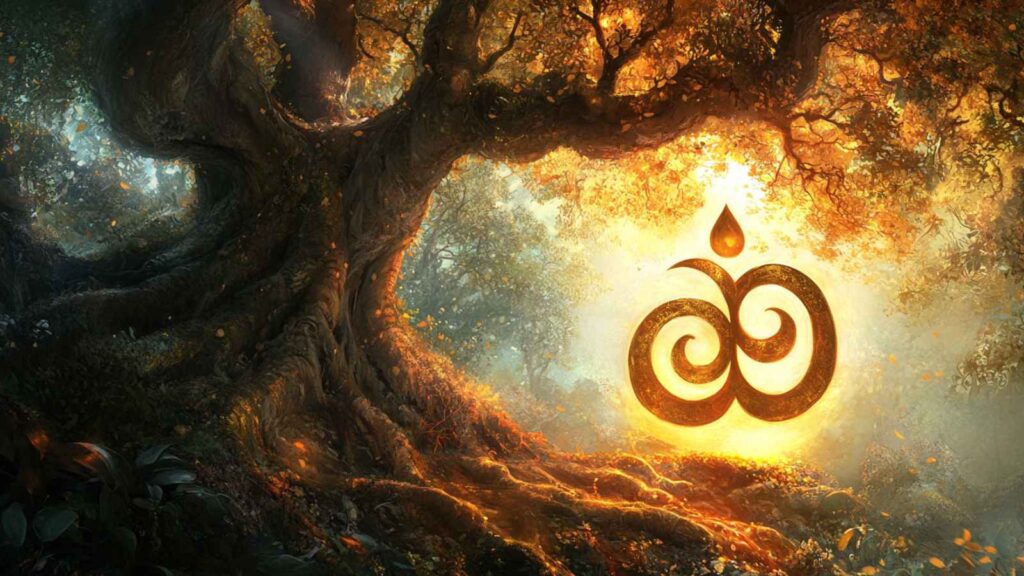Chandogya Upanishad: Exploring the Sacred Syllable Om and Its Cosmic Significance
The Chandogya Upanishad, one of the most revered and profound texts in the Upanishadic tradition, delves into the essence of Hindu spirituality and philosophy. Among its most central teachings is the sacred syllable Om, a symbol that resonates deeply with the spiritual seeker. Om (also spelled Aum) is far more than just a sound—its cosmic significance pervades Hindu thought and is considered the very essence of the universe.
Read More About sacred texts
In this article, we will explore the role of Om in the Chandogya Upanishad, examining its spiritual, philosophical, and cosmic meanings. Through this exploration, we will gain insights into the Chandogya Upanishad’s teachings on Brahman, the ultimate reality, and how Om serves as a bridge between the individual soul (Atman) and the infinite universe. The Chandogya Upanishad reveals that by understanding and meditating on Om, one can attain self-realization and experience oneness with the divine.
Introduction to the Chandogya Upanishad

The Chandogya Upanishad is one of the oldest Upanishads and is part of the Sama Veda, a sacred text that is concerned with the musical chanting of hymns. This Upanishad holds significant importance in Hindu philosophy, as it provides in-depth teachings on Brahman, Atman, and the path to spiritual liberation (moksha). The text is a dialogue between Uddalaka Aruni and his son Shvetaketu, where the father imparts essential spiritual knowledge to his son.
The Chandogya Upanishad explores various aspects of the cosmic order, including rituals, meditation, and the nature of existence. It teaches that everything in the universe is connected and ultimately derived from a single, eternal source—Brahman. One of the most significant teachings of this Upanishad is the profound importance of Om, the sacred syllable that represents the essence of Brahman itself.
The Significance of Om in the Chandogya Upanishad

Om is not merely a sound but a profound symbol of the universe. In the Chandogya Upanishad, Om is depicted as the essence of the cosmic vibration, the foundational frequency of existence. It is a mantra (sacred utterance) that represents the highest form of knowledge and consciousness. Om is considered to embody the triune nature of the universe—creation, preservation, and destruction—and is therefore a symbol of the entire cosmic cycle.
The Upanishad explains that Om is the very sound of the universe—it is present at the beginning, middle, and end of time. By chanting or meditating on Om, one can attune themselves to the ultimate reality and gain insight into the true nature of the self. The sacred syllable Om also represents the Atman, the individual self or soul, and its union with Brahman, the supreme, all-pervading reality.
Om as the Sound of Creation
The Chandogya Upanishad elaborates on Om’s role in creation, particularly in the section known as the Omkara Vidya (the knowledge of the syllable Om). According to the Upanishad, Om is not only the essence of Brahman but also the sound that brings the universe into existence. The syllable A represents the creation of the universe, U signifies its preservation, and M represents its destruction. In this way, Om encapsulates the entire cycle of existence, emphasizing the interconnectedness of all things.
The Upanishad further explains that the recitation of Om leads to an experience of the profound, all-encompassing Brahman. Chanting Om with full understanding and devotion brings the practitioner into a state of heightened awareness, where they begin to recognize their essential oneness with the universe.
Om as the Sound of the Universe
In the Chandogya Upanishad, Om is also described as the sound that is present at the heart of every atom, pervading all aspects of creation. This concept is illustrated in the famous teaching of Tat Tvam Asi (“That Thou Art”), a phrase that points to the realization that the individual self (Atman) is ultimately the same as the universal soul (Brahman). By meditating on Om, the practitioner can transcend the illusion of separation and experience the oneness of all existence.
The Upanishad presents Om as the central sound that connects all of creation. It is the sound of consciousness, the eternal vibration that links the individual with the divine. In this sense, Om is not only a cosmic symbol but also a tool for spiritual awakening, guiding the seeker toward the realization of their own divine nature.
Teachings of the Chandogya Upanishad
The Chandogya Upanishad is rich in teachings that guide the seeker on the path of self-realization. Its insights into Brahman, Atman, and the nature of reality form the philosophical backbone of Hinduism.
1. The Concept of Brahman
The Chandogya Upanishad teaches that Brahman is the ultimate reality, the source of all creation, and the essence of the universe. Brahman is described as Nirguna (without attributes) and Saguna (with attributes), representing both the formless and the manifest aspects of the divine. Brahman is eternal, indivisible, and omnipresent, existing beyond time, space, and matter.
Through meditation and contemplation on Om, one can experience a direct connection to Brahman, transcending the limitations of the physical body and the material world. The ultimate goal of this realization is to experience moksha, or liberation, where the individual soul merges with the supreme reality.
2. The Self (Atman) and Its Relationship with Brahman
One of the most profound teachings of the Chandogya Upanishad is the concept of the Atman, or the individual self. The Upanishad teaches that Atman is not separate from Brahman but is, in fact, Brahman itself. This realization of oneness between the individual soul and the universal spirit is the key to spiritual enlightenment.
In the famous dialogue between Uddalaka Aruni and Shvetaketu, Uddalaka imparts the knowledge that “You are That”—indicating that the true nature of the self (Atman) is identical with the ultimate reality (Brahman). By understanding this truth, the seeker attains spiritual awakening and liberation from the cycle of birth and death (samsara).
3. The Power of Meditation and Chanting Om
The Chandogya Upanishad teaches that one can realize the nature of Brahman through meditation and the repetition of sacred mantras, particularly the chanting of Om. By focusing on Om, the practitioner can achieve a state of inner stillness and awareness, which allows them to experience the unity of the self with the universe. The sound of Om is not merely a vibration; it is the key to accessing the divine consciousness that underlies all of existence.
The Relevance of the Chandogya Upanishad in Modern Spirituality
The Chandogya Upanishad continues to be a vital text in the modern spiritual world. Its teachings on the sacred syllable Om and the unity of Atman and Brahman provide a timeless framework for meditation, self-inquiry, and spiritual growth. Today, many spiritual seekers across the world turn to this Upanishad for guidance on the path to self-realization.
The Chandogya Upanishad’s teachings on Om also resonate deeply with practices like yoga and chanting. The concept of Om as the sound of the universe is reflected in the practice of chanting Om (or Aum) as a tool for achieving inner peace, focus, and connection to the divine. Meditation on Om has become a central practice in Hinduism, Buddhism, and New Age spirituality, where it is used to cultivate spiritual awareness and mindfulness.
Conclusion: The Cosmic Significance of Om in the Chandogya Upanishad
The Chandogya Upanishad offers profound wisdom on the nature of existence, the self, and the universe. By exploring the sacred syllable Om, the text reveals that this ancient sound is more than just a mantra; it is the essence of creation itself, a symbol of the interconnectedness of all things. Through chanting, meditation, and contemplation on Om, the seeker can transcend the illusion of separation and realize their true nature as one with the divine.
The Chandogya Upanishad continues to serve as a cornerstone of Hindu spiritual thought, offering a pathway to self-realization and liberation. Its teachings on Om remain as relevant today as they were thousands of years ago, guiding seekers toward the realization of their oneness with the infinite.


